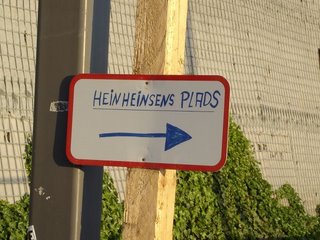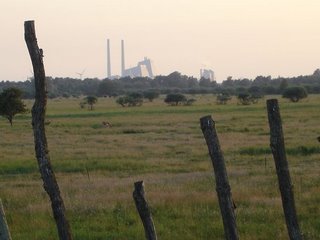Space is fundamental in any form of communal life. Space is fundamental in any excercise of power. Michael Foucault
Rumours are buzzing about holes in the fence cut by anglers, camping, self-built sheds, architecture like in the picture above and big investment plans.The area by Århusgade comes from landfills around 1900 and has functioned as a combined port and industrial area – for instance the harbour has housed Nordisk Film and the arms factory Dansk Industri Syndikat (The Rifle Syndicate), which was sabotaged during the Occupation.The large landfilled area north of the Free Port of Copenhagen was created with the reception of excavation fill over the last 30-40 years. Here we can still see the great hall that was used for casting the tunnel elements for the Øresund link.
Meeting-point: Nordhavn Station.
Date and time: Sunday, 13 May 2007, 12 pm.

It is perhaps appropriate to start with a strategy that doesn’t work; become part of the surroundings and sit quite still. The consequences of neoliberal urban development are becoming increasingly more obvious: standardisation and social imbalance. The most striking havens face the threat of being cleared by force, but just as many places are being subjected to an ongoing transformation into boring and lifeless suburban extensions.

Now and then the city offers a direct picture or caricature of contemporary developments: at the entry to Nordhavn we find a number of large pension companies, and those who are probably not insured on the other side of the tracks.

There are, however, still many places in Copenhagen that are different and special and have resisted the property market and normalisation. Nordhavn is one of them.

A good example of the unsentimental use of cheap materials. We thought that if it wasn’t eternit, it might well be asbestos sheets left over from a renovation.

Apple trees along the waterside

There were 10-12 of us on the walk – here leaving Kattegatvej. A large part of Nordhavn is industry and fencing. After 9/11 legislation in Denmark was also tightened to the benefit of the police and the detriment of civil rights. One of the measures was the increased screening off of ports and harbours. In certain places one can be charged under the anti-terror laws for climbing over a fence to find a good sport for fishing.

We met a resident of the area who was kind enough to let us in through a fenced-in area after having told us a little about Nordhavn. It is at present owned by the Port of Copenhagen and there is a local plan that stipulates that Nordhavn should be used for harbour-related activities. Some firms are here, however, even though they only import something or other that has nothing to do with the harbour. But if the municipality takes over, and the local plan is changed, anything could happen.

Between roughly 10 am and midday one can buy freshly caught fish – cod and plaice that are still wriggling. Go to the outer pier – it’s worth the walk.









































